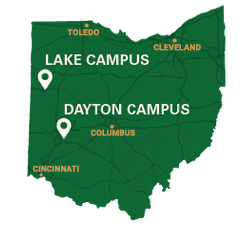Audio and Visual Support
Support
For questions and support for these topics, submit a consultation request to WSO through ServiceNow.
On this page:
The creative and technical fundamentals of graphic design and audio/video production can improve the quality of any course in any setting. This is especially true for asynchronous courses where slides, audio, and video are the primary means of communicating with students.
Graphic Design
Graphic design refers to the creation and arranging of visual content (e.g., images, typography, overall layout) to enhance content and communicate with audiences more effectively. Knowing the fundamentals of graphic design can improve many areas of your course. Good design makes lecture slides more memorable and easier to process and retain. Graphic design knowledge also supports your learners with reduced vision, ensuring that documents are readable and that the right things are being emphasized.
Best Practices for Graphic Design
Stock Photography
Wright State users have access to Adobe Creative Cloud, which has extensive stock photography resources to improve the visuals in your course. For a sample of their free stock resources that don’t require sign-up, check out the Free collection at Adobe Stock.
Additional stock resources
For more information about the intersection of graphic design and accessibility (e.g., color contrast, font choice), refer to the WSO page on Accessible Course Materials.
Audio and Video Recording
For online and hybrid courses, learning how to record and present high-quality audio and video to your students is a central skill. Recording your own content is both a creative and technical process, and it will take some trial and error to learn and get comfortable with. This can be intimidating, but Wright State Online is always developing new content to make this process easier and more approachable.
On-Campus Studios
Wright State has several recording studios outfitted with high-quality microphones, Wacom monitors, and webcams to make your recordings simpler.
24/7 Access - University ID card swipe required
- 344 Millett Hall
- 222, 224, 226 Rike Hall
- 212 Oelman Hall
Available by appointment 9 A.M.-4 P.M.
- 442 Millett Hall
Best Practices for Recording
The following are some tips to consider prior to a recording session, to ensure your content sounds clear and professional.
- Do short practice recordings first
- It's important to be comfortable with the software you’re using.
- You can preview how a recording will look to your students and make sure it aligns with your vision.
- Take note of how clear your audio is, and whether you would be satisfied as a learner with the quality of your lecture.
- Break up your recording sessions
- This ensures that the same level of focus and energy is given to the last lecture you record as with the first.
- Spacing out recording sessions reduces voice strain
- No jangly jewelry or accessories while recording
- Microphones are sensitive and will pick up noise in the room, especially if it’s close to the microphone.
- Try not to hit or tap the microphone while recording
- This includes adjusting settings on your microphone mid-recording.
- Avoid hitting your table or desk with your knees, hands, elbows, etc., especially if your microphone sits on your desk.
- Silence your devices
- If possible, turn off your phone. Incoming messages can cause interference with microphones, or just interrupt your train of thought with an ill-timed text alert.
- Enabling ‘Do Not Disturb’ on the device you’re recording on is also strongly recommended to protect your privacy and keep recordings focused.
- If recording at home, reduce atmospheric noise
- Turn off fans, humidifiers, or other subtle sources of noise that are close to your recording area.
- Find a quiet time of day to record (e.g., no lawn mowers or leaf blowers outside, when the kids or dog is asleep)
- If using screen recording, clean up your desktop prior to beginning a session
- Any private documents, e-mails, or other material on your desktop or open in website browsers will be visible on a screen recording if they are on-screen.
- Prepare all your materials and have them arranged how you’d like before you begin recording to save yourself time and avoid showing any personal information.
Microphones
High-quality audio is the most important part of a lecture recording. It serves as the foundation for accurate closed captions and is essential to understanding your material. Faculty should strive to have audio as clear as if your online students were sitting in front of you in a lecture hall.
Most external microphones are going to produce better audio than the internal mic on your computer.
CaTS offers microphones through their equipment checkout on a first-come-first-serve basis. For more information, visit the CaTS website.
If you do a lot of home recording and would like to invest in equipment to improve quality, a microphone should be your first consideration.
Recommended microphones for home recording include:
- Yeti series (Logitech)
- Snowball series (Logitech)
- ATR2100 series (Ars Technica)
- PGA48 (Shure)
Recording and Editing Software
The following software is available for free to Wright State Users.
Panopto
For the simplest experience recording audio and video, use Panopto. It’s user-friendly and will integrate directly with your course in Pilot.
The recording software is cloud-based, making file management easier and reducing the risk of lost files or recordings.
Guides
- Panopto Set-Up and Installation (PDF)
- Generating ASR Closed Captions (video and PDF)
- More coming soon!
Additional Resources
Camtasia
For more creative control with your recording and editing, Camtasia is a user-friendly option. Camtasia offers simple click-and-drag editing, easy audio enhancement, and higher quality files.
There are also many features that can be helpful with instruction, such as cursor highlighting and displaying keyboard input. File management requires more care with this program and there is an initial learning curve that will require some trial-and-error.
Resources
Adobe Premiere Rush
An alternative to Camtasia is Adobe Premiere Rush, also available for free to Wright State users. Premiere Rush has more aesthetic options than the other programs but is otherwise very similar in skill level to Camtasia. Premiere Rush has simple editing tools, audio enhancement, quality control, and overall user interface. The drawbacks are also similar, with file management and an initial learning curve.
Adobe products require using Adobe Creative Cloud, available for free to Wright State Users.
Resources
Adobe Premiere
For professional-level production and editing, Adobe Premiere is the best choice. The learning curve for this software is more extreme, but it allows for complete creative control.
There are entire courses available on Linkedin Learning and YouTube to teach techniques with Premiere. Listed below are a few getting started topics to get you familiar with the software.

